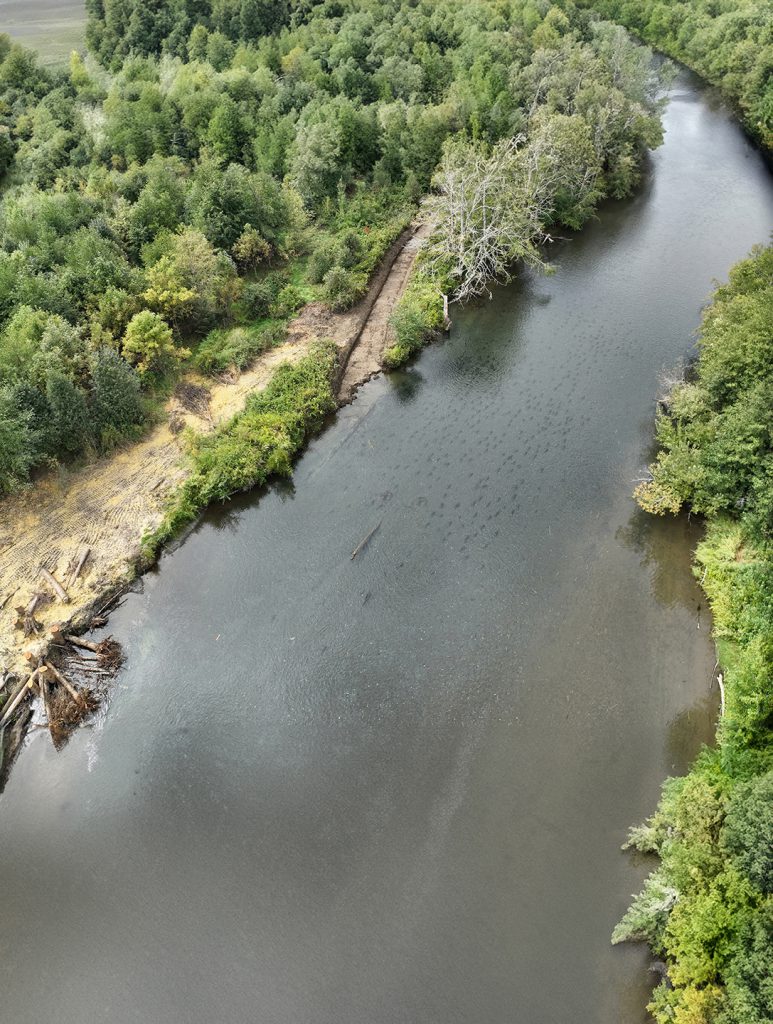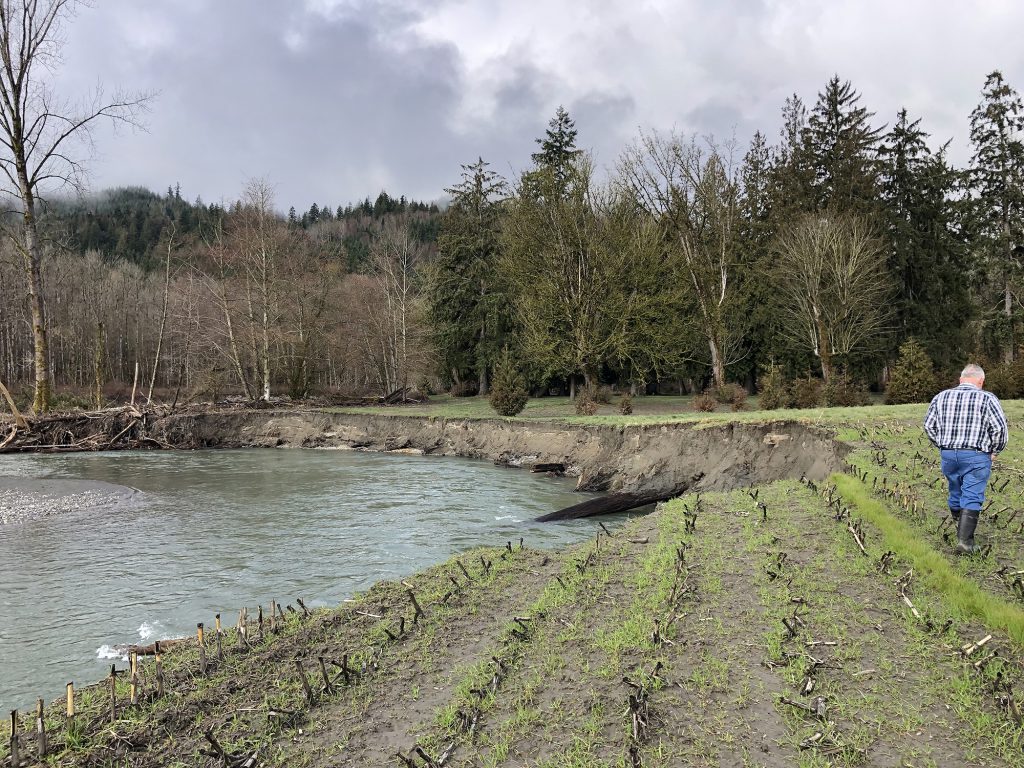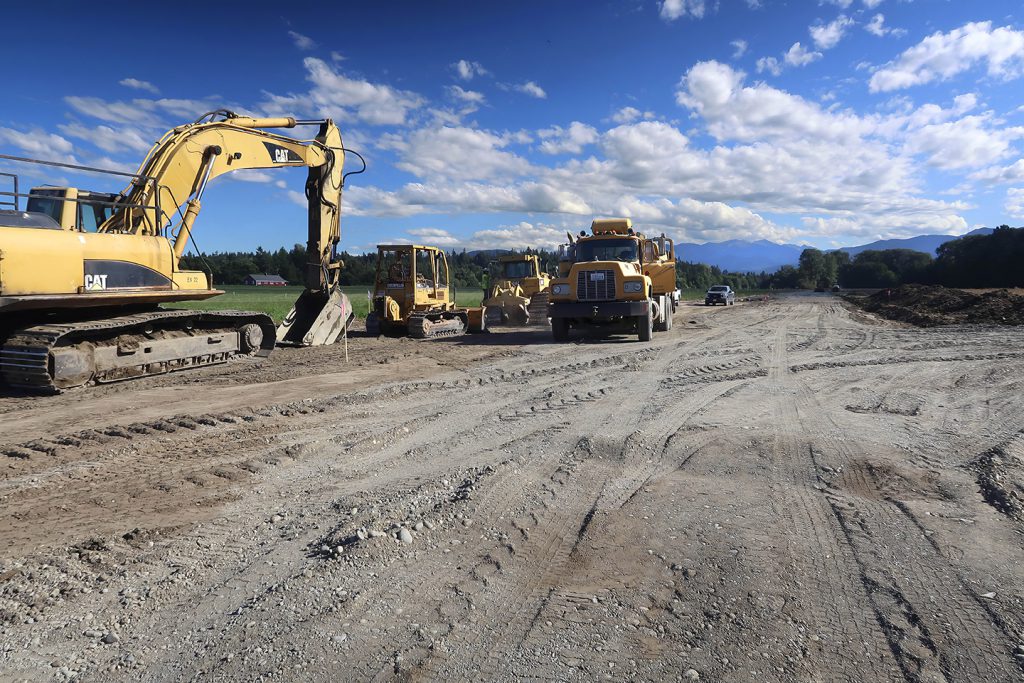Effective floodplain management can protect communities, recover endangered species, and uphold Tribal treaty rights.

Partnership pursues policy changes to facilitate resilient floodplains for people and salmon
Floodplains—low-lying areas adjacent to river channels or estuaries that can be inundated by flood water or subject to channel migration—provide invaluable ecosystem services, including flood damage mitigation, improved water quality, economically valuable farmlands, recreational opportunities, and critical wildlife habitat for salmon and other species. Here in the Pacific Northwest, our floodplains are especially dynamic landscapes, shaped and reshaped annually by high flows every winter and spring.
Federally endangered salmon species rely on healthy, connected floodplains for crucial spawning and rearing habitat and as a source of clean, cold water during summer months.
Unfortunately, many floodplains in the Pacific Northwest no longer function in their natural form because they have been restructured to meet urban and agricultural needs. Development disconnects river channels from their floodplain and destroys natural riparian upland and wetland vegetation. There is a direct, pronounced relationship between this loss of floodplain function and declining salmon runs—and with them, a failure to uphold Tribal treaty rights.
“Floodplains and salmon are deeply connected,” said Melissa Speeg, salmon recovery manager at the Puget Sound Partnership. “Young salmon rely on them for shelter and food when rivers and streams swell from flooding and spring snowmelt. Healthy floodplains with trees and plants slow the flow of water during flooding, providing a place for salmon to shelter and benefits to people that live downstream. Because floodplains slow water down, nutrients accumulate making the soil rich, which is why agriculture lands are located along rivers. For this reason, the cycle of flooding and floodplains is just as important to people as it is to salmon and re-establishing them is key for our future.”
Reversing that trend—and doing so in a timeframe that will prevent salmon from going extinct—will require bold, innovative policy solutions at all levels of government. Federal, state, and local governments work together to manage and regulate activity within our floodplains for multiple benefits, including protecting human life and property, recovering endangered species, and upholding Tribal treaty rights.
“Floodplains and salmon are deeply connected…[T]he cycle of flooding and floodplains is just as important to people as it is to salmon and re-establishing them is key for our future.” — Melissa Speeg, salmon recovery manager at the Puget Sound Partnership
For several decades, FEMA Region X maintained a “Policy on Fish Enhancement Structures in the Floodway” that recognized the urgent need to restore anadromous fish habitat and allowed for “less than the maximum hydraulic analyses” in cases where informed judgement confirmed that the project was designed to minimize any impact to flood levels and that no structures would be impacted by any rise.
In 2020, that policy was rescinded. As a result, current National Flood Insurance Program’s (NFIP) standards do not differentiate between requirements for habitat restoration projects versus development projects or provide any exceptions for projects that pose no risk to existing structures. According to a FEMA FAQ on the rescindment, “habitat restoration floodway projects have the potential to alter the risk communicated by a community’s flood maps and therefore must undergo the same rigorous review as other floodway development. NFIP regulations provide one set of requirements for all floodway development.”
Unfortunately, those “rigorous reviews” can be costly, especially for critical salmon habitat restoration projects operating on tight, piecemeal budgets. These “no-rise” analyses, and the Conditional Letter of Map Revision (CLOMR) they inform, are lengthy processes that can cast delay and uncertainty over planned construction timelines. These delays further increase costs and jeopardize grant funding, and in some cases can cause a project to miss a narrow construction season entirely—meaning that river-reshaping winter storms will render the previous hydraulic analysis obsolete and bring the entire process back to square one.

The Puget Sound Partnership (Partnership) surveyed local, watershed-based salmon recovery organizations (Lead Entities) and project sponsors across the state of Washington to assess the extent and magnitude of impacts to projects. Preliminary responses indicated that at least 26 salmon recovery projects, representing an investment of over $170 million in state and federal funding, are experiencing delays and cost increases. This is almost certainly an undercount, because project sponsors in the Lower Columbia noted that they have abandoned pursuing projects in the floodplains entirely for the time being in order to avoid the hassle and expense of a no-rise process.
Examples of delays are included below.
Skokomish River Mile 5
The Skokomish River Mile 5 project received $870,902 in federal funding and $1,217,856 in state funding. The project was originally intended to restore nearly two miles of instream and floodplain habitat to benefit four Endangered Species Act-listed salmonid populations in a single phase, but to accommodate the costs associated with no-rise analyses, the project was redesigned and split into multiple phases. This resulted in a multi-year delay, a reduced project scope, and required nearly half a mile of expensive side-channel excavation for the sole purpose of meeting no-rise requirements. As a result of these unanticipated costs and phased approach, completing the remainder of the project is indefinitely delayed.
Satsop River Mile 2.5
The Satsop River Mile 2.5 project received $5.1 million in state funding. To comply with the “no-rise” policy, this project was redesigned and as a result has been delayed by up to two years. The project redesign increased project costs by approximately $100,000 and decreased project efficacy compared to the original design. During the delay of project implementation, the riverbank has continued to erode, jeopardizing the landowner’s willingness to stay committed to implement the project.
“The Satsop River Mile 2.5 project highlights that FEMA’s no-rise policy de-incentivizes the implementation of nature-based solutions to rapid channel migration and erosion issues,” said Anthony Waldrop, watershed restoration project manager with Grays Harbor Conservation District. “Conversely, it increases the likelihood that our communities will have to use emergency, non-nature-based techniques to protect public infrastructure and homes.”
“The Satsop River Mile 2.5 project highlights that FEMA’s no-rise policy de-incentivizes the implementation of nature-based solutions to rapid channel migration and erosion issues.” — Anthony Waldrop, watershed restoration project manager with Grays Harbor Conservation District.
South Fork Nooksack Homesteader
The South Fork Nooksack Homesteader project received $2.6 million in federal funding and $1.1 million in state funding. To comply with the “no-rise” policy, this project was redesigned and as a result has been delayed by more than two years. The redesign and delays have resulted in cost increases of almost $400,000 and have caused a domino effect of delaying other vital restoration projects in the South Fork Nooksack River. Meanwhile, the riverbank continues to erode during annual flood events, testing not only the particular landowner’s patience to stick with the project, but also potentially hindering community support for future restoration projects in the area.
Without the FEMA no-rise policy, the project would have been constructed in 2022-2023 and would not have had to undergo costly redesign and a rigorous modeling process to update the outdated FEMA floodway model.
“After two years of delays, hundreds of thousands of dollars in engineering and hydraulic modeling cost increases, and almost one-year of FEMA review since our submittal last May, I believe we are finally close to receiving our first CLOMR and hopefully will be constructing the South Fork Nooksack Homesteader Restoration Project this summer,” said Lindsie Fratus-Thomas, watershed restoration coordinator with the Nooksack Indian Tribe Department of Natural Resources. “To say that the CLOMR process has been frustrating and burdensome would be an understatement. However, we remain hopeful that recent advocacy efforts calling for policy-level change will result in collaborative solutions that truly integrate flood risk reduction, climate resilience, and recovery of our ecosystems and salmon.”
“After two years of delays, hundreds of thousands of dollars in engineering and hydraulic modeling cost increases, and almost one-year of FEMA review since our submittal last May, I believe we are finally close to receiving our first CLOMR and hopefully will be constructing the South Fork Nooksack Homesteader Restoration Project this summer.” — Lindsie Fratus-Thomas, watershed restoration coordinator with the Nooksack Indian Tribe Department of Natural Resources.

These issues have even caught the attention of Washington state’s senior senator – and Chair of the powerful Appropriations Committee, Patty Murray. At a recent budget hearing for the Department of Homeland Security (which includes FEMA), Sen. Murray noted to Secretary Alejandro Mayorkas:
“Habitat restoration projects in my home state of Washington – and really throughout the country – are really key to recovering ESA-listed species like salmon and upholding Tribal treaty rights. However, the current standards for FEMA’s current National Flood Insurance Program do not differentiate between requirements for habitat restoration projects and development projects like parking lots or strip malls. So, because of that, habitat restoration projects that pose minimal risk to people or structures often experience very lengthy permitting delays and millions of dollars in cost increases. In some cases, our local partners have given up on pursuing habitat projects entirely because of these FEMA rules.”
Senator Patty Murray
Sen. Murray asked Secretary Mayorkas to work with her to ensure that habitat projects would move forward in a timely and cost-effective manner. Regionally, FEMA has already taken steps to support those goals through its participation in the Puget Sound Federal Leadership Task Force, and more specifically through its ongoing engagement with the Multi-agency Review Team (MART) that helps shepherd restoration projects through state and federal permitting processes. In its first Biennial Report, the Task Force also recommended that FEMA (and Congress, where necessary) “develop policies that allow for expedited FEMA CLOMR review for restoration projects.”
To that end, the Partnership is working to support policy solutions that will:
- Revise the NFIP’s definition of development to add specific definitions for restoration activities.
- Develop new guidance for those restoration activities, incorporating a safe level of flexibility for no-rise analyses and providing expedited review and map revision processes.
According to the FEMA FAQ on the rescindment, the agency “recognizes that habitat restoration projects promote the natural and beneficial functions of floodplains and contribute significantly to a community’s proactive long-term management of its flood risks as well as the recovery and sustainability of threatened species.” The impacts to dozens of habitat restoration projects through Washington state (and beyond) strongly indicate that providing more flexibility in the no-rise requirement for restoration projects with willing landowners that pose no adverse impact to existing insurable structures will better meet the needs of our region’s threatened and endangered species and their habitats, while promoting natural and beneficial functions of floodplains that can reduce a community’s risk. The future management of resilient floodplains for the wellbeing of both people and salmon may just depend on it.
“Given a recent mortality event in 2021, where over 2,400 Chinook died on the spawning grounds before they could spawn, the importance and urgency of our work cannot be overstated,” said Fratus-Thomas. “Our South Fork Nooksack River populations can’t afford delays such as those we have experienced the last two years while navigating the FEMA CLOMR process.”
“Given a recent mortality event in 2021, where over 2,400 Chinook died on the spawning grounds before they could spawn, the importance and urgency of our work cannot be overstated. Our South Fork Nooksack River populations can’t afford delays such as those we have experienced the last two years while navigating the FEMA CLOMR process.” — Lindsie Fratus-Thomas, watershed restoration coordinator with the Nooksack Indian Tribe Department of Natural Resources.
Unintended consequences
Salmon recovery projects subject to no-rise analyses face:
- Delayed construction: average delays of 17 months relative to the expected design and construction timeline.
- Cost increases: $4.56 million in cumulative cost increases across all 26 projects.
- Stalled public investment: Across Washington state, delays have stalled the use of $128.5 million in federal funding and $47.6 million in state funding across Washington state. Some projects have been shelved entirely.
- Fewer habitat gains: More than two-thirds of project sponsors report that projects must be redesigned to meet no-rise requirements—and therefore are less effective for salmon recovery.
- Jeopardized landowner participation: 20 percent of projects report that landowner willingness—and therefore the entire project—has been jeopardized as a result of delays and redesigns stemming from no-rise requirements.
Written by:
Ahren Stroming, special assistant for federal affairs at the Puget Sound Partnership
Melissa Speeg, salmon recovery manager at the Puget Sound Partnership
April Gassman, salmon permitting projects coordinator at the Puget Sound Partnership
Megan Wilson, salmon monitoring data steward at the Puget Sound Partnership
Washington State Lead Entities for salmon recovery

